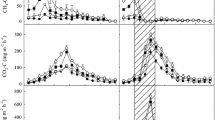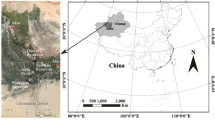Abstract
Controlled drainage (CD) can reduce outflow and improve soil productivity, whereas its impacts on soil nitrogen (N), moisture contents, and cotton (Gossypium hirsutum L.) yield at reduced N rates remain largely unknown. To address the question, a field experiment was conducted to investigate the effects of N fertilizer rates (280, 252, 224, and 196 kg N ha−1, designated N1, N0.9, N0.8, and N0.7, respectively) on soil moisture, nitrate N (NO3−–N), and ammonium N (NH4+–N) contents and yield of cotton under CD and free drainage (FD). Compared to FD, CD increased the soil moisture, NO3−–N, and NH4+–N contents in the 0–40 cm soil depths, leading to greater plant N uptake at each N rate. The decreased total N loss through runoff due to CD accounting for the enhanced soil N contents. Moreover, CD had greater soil NO3−–N content at the reduced N treatments, contributing to the enhanced plant N accumulation, number of bolls, and lint percentage, and thus obtains a relatively high cotton yield. Remarkably, cotton yield reduced significantly with the decrease in N rates under FD, but it was comparable between N1 and N0.9 or N0.8 under CD. These suggested that CD helps to maintain high soil N and moisture contents in the 0–40 cm soil depths at 10–20% reductions in N fertilizer rate and thus without compromising cotton yield. The results also provide scientific basis for drainage water management mediates cotton yield at reduced N fertilizer rates.




Similar content being viewed by others
Data Availability
The obtained data will be available upon request.
References
Awale R, Chatterjee A, Kandel H, Ransom JK (2015) Tile drainage and nitrogen fertilizer management influences on nitrogen availability, losses, and crop yields. Open J Soil Sci 5:211–226. https://doi.org/10.4236/ojss.2015.510021
Ballantine DJ, Tanner CC (2013) Controlled drainage systems to reduce contaminant losses and optimize productivity from New Zealand pastoral systems. New Zeal J Agric Res 56:171–185. https://doi.org/10.1080/00288233.2013.781509
Bateman EJ, Baggs EM (2005) Contributions of nitrification and denitrification to N2O emissions from soils at different water-filled pore space. Biolo Ferti Soil 41:379–388. https://doi.org/10.1007/s00374-005-0858-3
Bao SD (2000) Soil and agricultural chemistry analysis, edn III. Chinese Agriculture Press, Bei**g (In Chinese)
Coskun D, Britto DT, Shi W, Kronzucker HJ (2017) Nitrogen transformations in modern agriculture and the role of biological nitrification inhibition. Nat Plants 3:17074. https://doi.org/10.1038/nplants.2017.74
Dou X, Shi HB, Li RP, Miao QF, Tian F, Yu DD, Zhou LY, Wang B (2021) Effects of controlled drainage on the content change and migration of moisture, nutrients, and salts in soil and the yield of oilseed sunflower in the Hetao Irrigation District. Sustainability 13(17):9835. https://doi.org/10.3390/su13179835
Fan Z, Zhao YX, Chen HN, Chen YR, Bu D, Xu JY, Guo XR, Wang Y, Tian XF (2022) Effects of irrigation and polymer-coated urea on water-nitrogen productivity and yield of winter wheat. J Soil Sci Plant Nutri 22:4717–4726. https://doi.org/10.1007/s42729-022-00954-1
Fang QX, Malone RW, Ma L, Jaynes DB, Thorp KR, Green TR, Ahuja LR (2012) Modeling the effects of controlled drainage, N rate and weather on nitrate loss to subsurface drainage. Agric Water Manage 103:150–161. https://doi.org/10.1016/j.agwat.2011.11.006
Ghane E, Fausey NR, Shedekar VS, Piepho HP, Shang Y, Brown LC (2012) Crop yield evaluation under controlled drainage in Ohio, United States. J Soil Water Conserv 67:465–473. https://doi.org/10.2489/jswc.67.6.465
Hanrahan BR, King KW, Williams MR (2021) Controls on subsurface nutrient losses from agricultural fields during precipitation-driven events. Sci Total Environ 754:142047. https://doi.org/10.1016/j.scitotenv.220.142047
Hu YX, Zeeshan M, Wang GY, Pan YQ, Liu YX, Zhou XB (2023) Supplementary irrigation and varying nitrogen fertilizer rate mediate grain yield, soil-maize nitrogen accumulation and metabolism. Agric Water Manag 276:108066. https://doi.org/10.1016/j.agwat.2022.108066
Jouni HJ, Liaghat A, Hassanoghli A, Henk R (2018) Managing controlled drainage in irrigated farmers’ fields: a case study in the Moghan plain. Iran Agric Water Manage 208:393–405. https://doi.org/10.1016/j.agwat.2018.06.037
Ju XT, **ng GX, Chen XP, Zhang S, Zhang L, Liu X, Cui ZL, Yin B, Christie P, Zhu Z, Zhang FS (2009) Reducing environmental risk by improving N management in intensive Chinese agricultural systems. PANS 106:3041–3046. https://doi.org/10.1073/pnas.0813417106
Karegoudar AV, Vishwanath J, Anand SR, Rajkumar RH, Ambast SK, Kaledhonkar MJ (2019) Feasibility of controlled drainage in saline vertisols of TBP command area of Karnataka, India. Irrig Drain 68:969–978. https://doi.org/10.1002/ird.2374
King KW, Hanrahan BR, Stinner J, Shedekar VS (2022) Field scale discharge and water quality response, to drainage water management. Agric Water Manag 264:107421. https://doi.org/10.1016/j.agwat.2021.107421
Krishna PD, Ahmad M, John PAL, Mina D, Paul LGV (2013) Mineral nitrogen dynamics in irrigated rice–wheat system under different irrigation and establishment methods and residue levels in arid drylands of Central Asia. European J Agron 47:65–76. https://doi.org/10.1016/j.eja.2013.01.009
Liu AD, Ma XL, Zhang Z, Liu H, Luo D, Yang LR, Lv N, Zhang YJ, Yang GZ, Dong HZ (2022) Single dose fertilization at reduced nitrogen rate improves nitrogen utilization without yield reduction in late-planted cotton under a wheat–cotton crop** system. Indus Crop Pro 176:114346. https://doi.org/10.1016/j.indcrop.2021.114346
Lu JS, Hu TT, Zhang BC, Wang L, Yang SH, Fan JL, Yan SC, Zhang FC (2021) Nitrogen fertilizer management effects on soil nitrate leaching, grain yield and economic benefit of summer maize in Northwest China. Agric Water Manage 247:106739. https://doi.org/10.1016/j.agwat.2021.106739
Luo Z, Liu H, Li WP, Zhao Q, Dai JL, Tian LW, Dong HZ (2018) Effects of reduced nitrogen rate on cotton yield and nitrogen use efficiency as mediated by application mode or plant density. Field Crops Res 218:150–157. https://doi.org/10.1016/j.fcr.2018.01.003
Nash P, Nelson K, Motavalli P (2015) Reducing nitrogen loss with managed drainage and polymer-coated urea. J Environ Quality 44:256–264. https://doi.org/10.2134/jeq2014.05.0238
Poole CA, Skaggs RW, Cheschier GM, Youssef MA, Crozier CR (2013) Effects of drainage water management on crop yields in North Carolina. J Soil Water Conserv 68:429–437. https://doi.org/10.2489/jswc.68.6.429
Qi DL, Hu TT (2017) Effects of varied nitrogen supply and irrigation methods on distribution and dynamics of soil NO3-N during maize season. J Agric Sci 9:1–14. https://doi.org/10.5539/jas.v9n1p1
Qi DL, Hu TT, Song X (2020) Effects of nitrogen supply methods on fate of nitrogen in maize under alternate partial root-zone irrigation. Inter Agric Bio Engin 13:129–135. https://doi.org/10.25165/IJABE.V13I3.5287
Qi DL, Hu TT (2022) Effects of nitrogen application rates and irrigation regimes on root growth and nitrogen‑use efficiency of maize under alternate partial root‑zone irrigation. J Soil Sci Plant Nutri 22:4717–4726. 22: 2793–2804. https://doi.org/10.1007/s42729-022-00846-4
Qi DL, Hu TT, Song X (2020a) Effects of nitrogen application rates and irrigation regimes on grain yield and water use efficiency of maize under alternate partial root-zone irrigation. J Inter Agric 19: 2792–2806. http://creativecommons.org/licenses/by-nc-nd/4.0/
Qiu HN, Yang SH, Jiang ZW, Xu Y, Jiao XY (2022) Effect of irrigation and fertilization management on rice yield and nitrogen loss: a meta-analysis. Plants 11:1190. https://doi.org/10.3390/plants11131690
Shedekar V, King KW, Fausey NR, Islam KR, Soboyejo AB, Kalcic MM, Brown LC (2021) Exploring the effectiveness of drainage water management on water budgets and nitrate loss using three evaluation approaches. Agric Water Manage 243:106501. https://doi.org/10.1016/j.agwat.220.106501
Thapa R, Chatterjee A, Johnson JMF, Awale R (2015) Stabilized nitrogen fertilizers and application rate influence nitrogen losses under rainfed spring wheat. Agronomy J 107:1–10. https://doi.org/10.2134/agronj15.0081
Tolimo M, Borin M (2018) Water table management to save water and reduce nutrient losses from agricultural fields – 6 years of experience in North-Eastern Italy. Agric Water Manage 201:1–10. https://doi.org/10.1016/j.agwat.2018.01.009
Wang HD, Wu LF, Cheng MH, Fan JL, Zhang FC, Zou YF, Chau HW, Gao ZJ, Wang XK (2018) Coupling effects of water and fertilizer on yield, water and fertilizer use efficiency of drip-fertigated cotton in northern **njiang, China. Field Crop Res 219:169–179. https://doi.org/10.1016/j.fcr.2018.02.002
Wang ZY, Shao GC, Lu J, Zhang K, Gao Y, Ding JH (2020) Effects of controlled drainage on crop yield, drainage water quantity and quality: a meta-analysis. Agric Water Manage 239:106253. https://doi.org/10.1016/j.agwat.2020.106253
Wang GY, Hu YX, Liu YX, Ahmad S, Zhou XB (2021) Effects of supplement irrigation and nitrogen application levels on soil carbon–nitrogen content and yield of one-year double crop** maize in subtropical region. Water 13:1180. https://doi.org/10.3390/W13091180
Wessröm I, Messing I (2007) Effects of controlled drainage on N and P losses and N dynamics in a loamy sand with spring crops. Agric Water Manage 87(3):229–240. https://doi.org/10.1016/j.agwat.2006.07.005
Wesström I, Joel A, Messing I (2014) Controlled drainage and subirrigation – a water management option to reduce non-point source pollution from agricultural land. Agric Ecosys Environ 198:74–82. https://doi.org/10.1016/j.agee.2014.03.017
Yan J, Wu QX, Qi DL, Zhu JQ (2022) Rice yield, water productivity, and nitrogen use efficiency responses to nitrogen management strategies under supplementary irrigation for rain-fed rice cultivation. Agric Water Manage 263:107486. https://doi.org/10.1016/j.agwat.2022.107486
Yuan Y, Lin F, Maucieri C, Zhang YJ (2022) Efficient irrigation methods and optimal nitrogen dose to enhance wheat yield, inputs efficiency and economic benefits in the North China Plain. Agronomy 12:273. https://doi.org/10.3390/agronomy12020273
Yuan NN, Huang J, Huang ZQ, **e H, Wu MS (2012) Effects of controlled drainage and nitrogen fertilizer application on nitrogen migration and transformation in dryland. Transactions CSAE 28:106–112 (in Chinese). CNKI:SUN:NYGU.0.2012–13–019
Zhang YC, Song XZ, Yang GZ, Li ZH, Lu HQ, Kong XQ, Eneji AE, Dong HZ (2015) Physiological and molecular adjustment of cotton to waterlogging at peak-flowering in relation to growth and yield. Field Crops Res 179:164–172. https://doi.org/10.1016/j.fcr.2015.05.001
Zhang HZ, Khan A, Tan DK, Luo HH (2017) Rational water and nitrogen management improves root growth, increases yield and maintains water use efficiency of cotton under mulch drip irrigation. Front Plant Sci 8:912. https://doi.org/10.3389/fpls.2017.00912
Zhang B, Chen L, ** S, Guo QZ, Hou J (2022) The influence of plants on the migration and transformation of nitrogen in plant-soil systems: a review. J Soil Sci Plant Nutri 22:4084–4102. https://doi.org/10.1007/s42729-022-01009-1
Acknowledgements
The authors would like to thank all the reviewers who participated in the review, as well as MJEditor (www.mjeditor.com) for providing English editing services during the preparation of this manuscript. The authors are also thankful to Ms. Yin Xu and Mr. Cheng Zhen, for providing their assistance in field investigation and nitrogen content measurements.
Funding
This work has been supported by the National Natural Science Fund of China (U21A2039) and Key laboratory of Nonpoint Source Pollution Control, Ministry of Agriculture and Rural Affairs of P. R. China (1610132016005).
Author information
Authors and Affiliations
Contributions
D.L.Q. was involved in the design of the work, acquisition and analysis of data, and writing of this paper. J.Q.Z. revised it critically for important intellectual content.
Corresponding author
Ethics declarations
Competing Interests
The authors declare no competing interests.
Additional information
Publisher's Note
Springer Nature remains neutral with regard to jurisdictional claims in published maps and institutional affiliations.
Highlights
Effects of controlled irrigation (CD) and nitrogen (N) rates on soil water, N contents, and cotton yield were investigated.
CD resulted in the greater soil NO3−–N content in the 0–40 cm soil depths at the reduced N rates.
Relatively high soil N and water contents contributed to the enhanced cotton N uptake under CD.
CD stabilized cotton yield at a reduced 10–20% of N fertilizers.
About this article
Cite this article
Qi, D., Zhu, J. Controlled Drainage Mediates Cotton Yield at Reduced Nitrogen Rates by Improving Soil Nitrogen and Water Contents. J Soil Sci Plant Nutr 23, 3655–3665 (2023). https://doi.org/10.1007/s42729-023-01285-5
Received:
Accepted:
Published:
Issue Date:
DOI: https://doi.org/10.1007/s42729-023-01285-5




